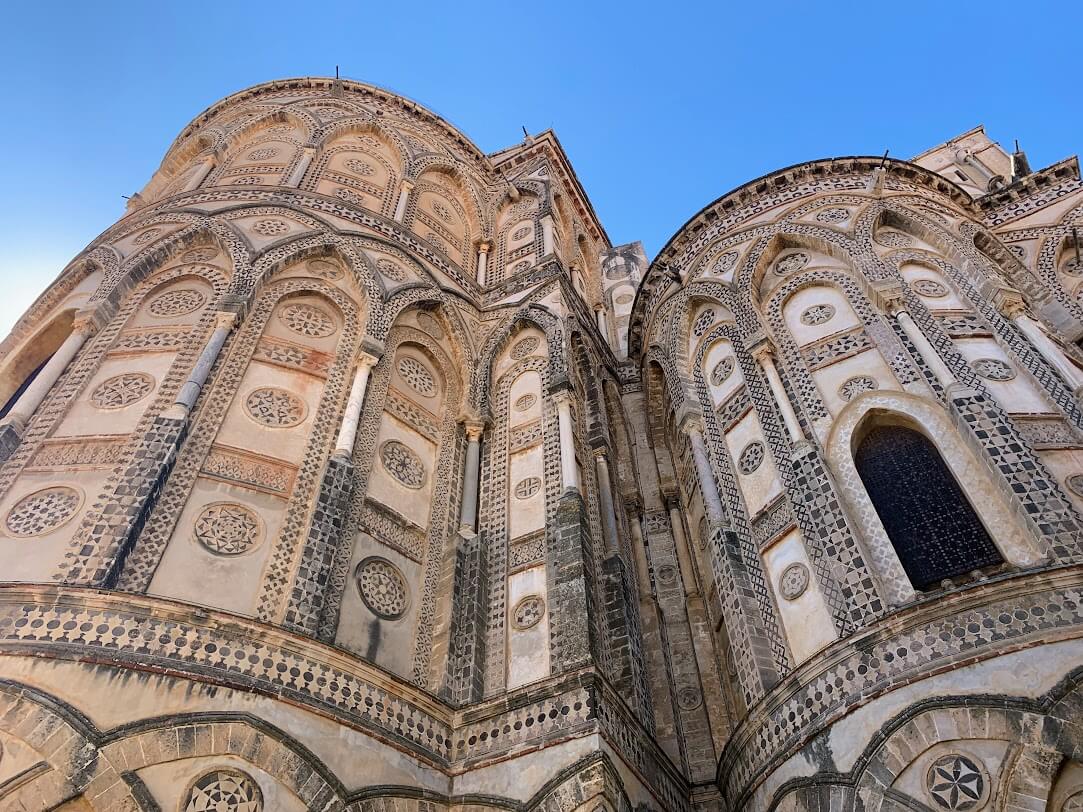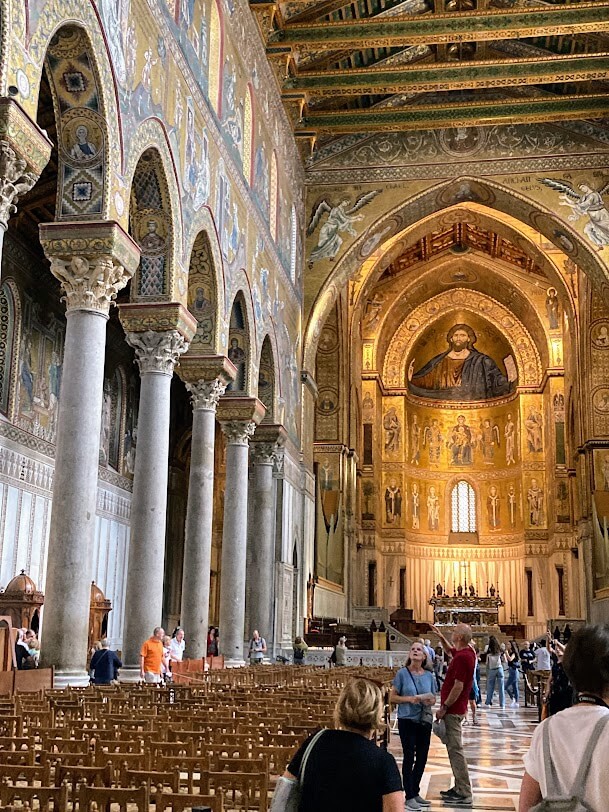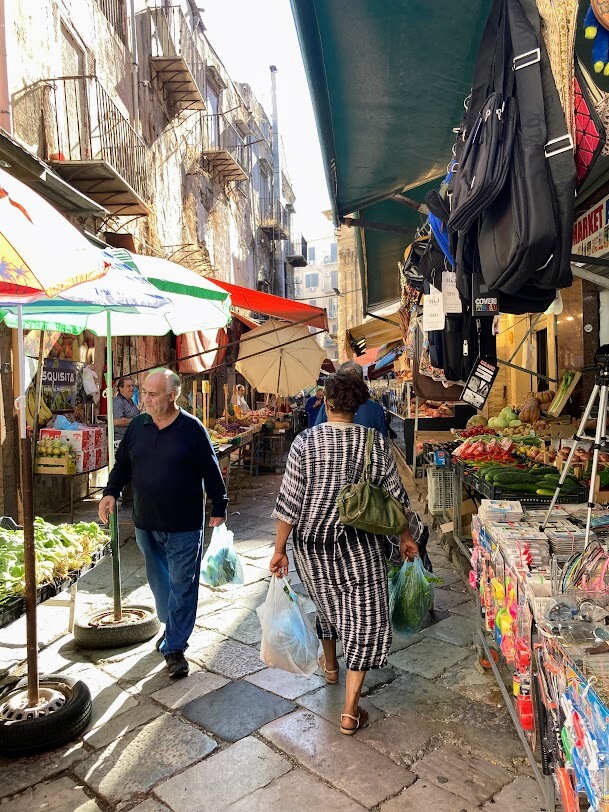- Home
- History of Sicily
- Emirate of Sicily
The Emirate of sicily - The rise and fall of arab rule in sicily
 Flag of the Emirate of Sicily.
Flag of the Emirate of Sicily.The Emirate of Sicily was an Islamic empire that ruled the island from 965-1091. (The actual Arab conquest of Sicily started way earlier, in 827.)
The capital of the state was Palermo. In fact, the Moors were the first to declare it a capital. After that, Palermo became an important cultural and political center for the Muslim world of the time.
Under Muslim rule, Sicily in general became a cosmopolitan and prosperous place. Palermo became one of the largest and wealthiest cities in Europe.
The period of Arab rule was a multicultural time. Sicilian life at that time was a combination of Arab, Byzantine, and Jewish cultures.
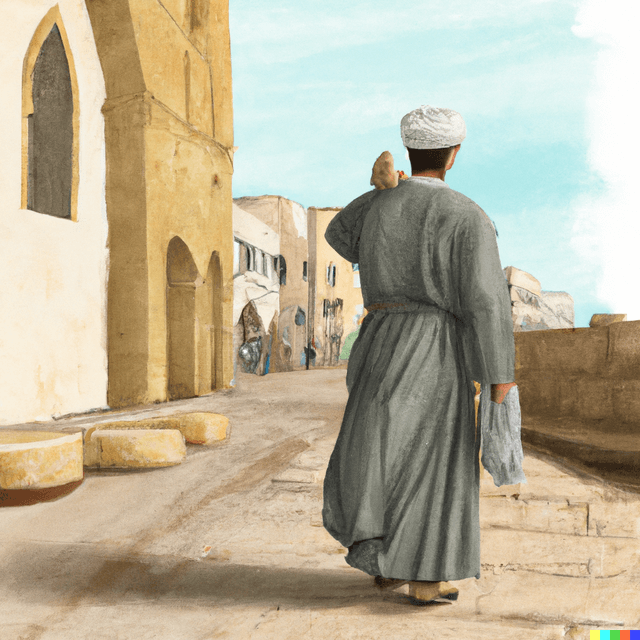 An Arab walking the streets of medieval Palermo.
An Arab walking the streets of medieval Palermo.The Emirate's power declined in the 1000s because of conflicts and power struggles within the ruling family.
Because of that, the Normans conquered Sicily from the Arabs in 1091. However, Muslims remained the largest group on the island until the 13th century. Then they were forced to either leave or convert to Christianity.
Arab History of Sicily
By the late 600s, Muslims had conquered North Africa. After the conquest of Carthage, the arabic forces established a navy there. With it, they were able to control the whole Mediterranean.
Sicily was only a short sea voyage away. So it was no wonder then, that it soon became the target of the Caliphate's conquest wars.
 The Muslims—or Moors, as they were then called—first landed in Western Sicily, as seen here from the hilltop town of Erice.
The Muslims—or Moors, as they were then called—first landed in Western Sicily, as seen here from the hilltop town of Erice.At that time, Sicily was under Byzantine rule. And it also might have stayed that way without a certain Euphemius. He was a former Byzantine navy officer who had fallen out of favor with his superiors.
Euphemius had tried to marry a nun, causing a schism with the rest of the naval leadership. This scandal led Euphemius to flee from Sicily. He landed in North Africa, where he made a deal with the Caliphate.
Euphemius promised to conquer Sicily for the Caliphate if they offered him protection. In hindsight, the deal was satisfactory to Arabs, but not so much to Euphemius. He was killed a couple of years later in Sicily.
The first battle took place on 5 July 827, near Mazara. Euphemius won it together with the Caliphate fleet. After that it still took well over a hundred years to conquer the whole of Sicily.
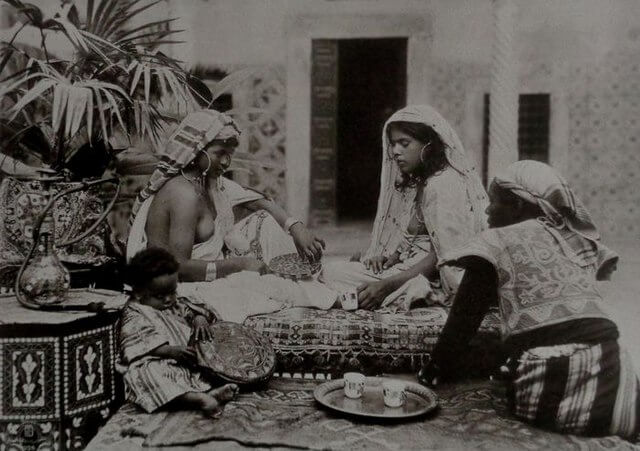 Berber women with their children in a photo taken in 1910. North African Berbers were the first Saracens to arrive in Sicily. (Wikimedia Commons)
Berber women with their children in a photo taken in 1910. North African Berbers were the first Saracens to arrive in Sicily. (Wikimedia Commons)Palermo: The Capital of the Emirate of Sicily
The Caliphate took over Palermo in 831. Soon after, people from North Africa began to move to the city.
In less than a hundred years, half a million Muslims were living in western Sicily. By 1050 most of the inhabitants in the western part of the island were Saracens.
Syracuse had been the center of power for 1500 years at this point. Now Muslims transferred power to Palermo, which became the capital of the Emirate of Sicily.
Palermo's city plan, as well as its status as the capital, dates from these times. The present cathedral stands on the site of what was once the city's mosque.
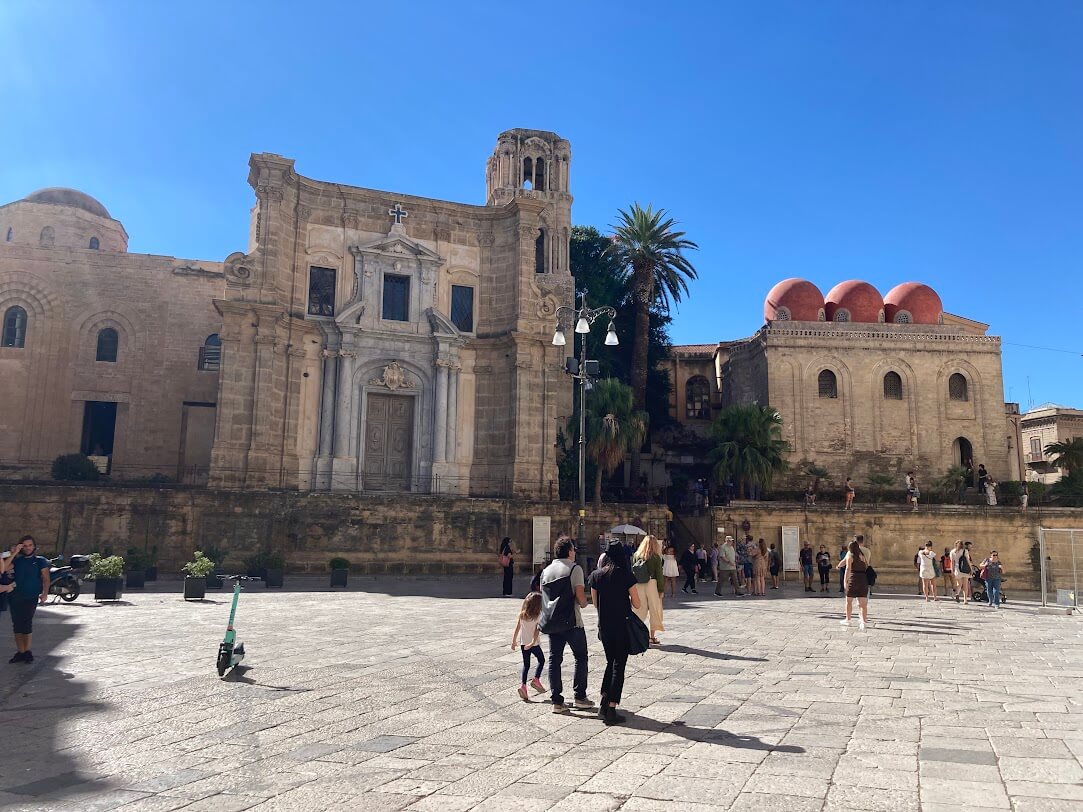 The domes on top of the Norman church in Piazza Bellini (on the right) are part of Palermo's Arab heritage.
The domes on top of the Norman church in Piazza Bellini (on the right) are part of Palermo's Arab heritage.Arab Conquest of the Rest of Sicily
By 850, the Moors had conquered half of Sicily. From 842 onwards, the focus of fighting shifted to the eastern part of the island.
By 860, the Christians had only Syracuse of the major cities for them to rule. It fell in 878. After Syracuse, several pockets of rebellion still remained. One of these was in Taormina, which fell only in 902.
By 965, the whole island was under Muslim control. Officially, however, the change of power had taken place earlier. Saracens had made a treaty with the Byzantines. It had happened some years before the fighting ended.
The Muslim camp had also undergone a change of power in the meantime. The power had passed from the Berbers of the Tunisian region to the Egyptian Arabs. That is, from the Aglabids to the Fatimids.
The Muslim dynasty that won Sicily from Byzantine was different from the one that lost it to the Normans. The religion was the same, but otherwise they were a different group of people.
The End of the Emirate of Sicily
The Emirate of Sicily fought the Christians both in Sicily and Calabria. In Sicily, there were Byzantine rebels. In Calabria, the troops of the Holy Romano-Saxon Empire.
However, these battles did not destroy the Emirate. Internal power struggles did.
Because of them, the various branches of the ruling family allied themselves with the Byzantines and the Cyrids. The latter was a Berber dynasty from what is now Algeria.
In Calabria, the rulers under Muslim attack made a pact with the Normans. These descendants of the Vikings were pilgrims who had found their way into southern Italy. There, they found out that they - after all - preferred fighting to prayer.
The Normans had worked as mercenaries for the southern Italian rulers for some time. And in this role, they encountered the Muslims, too.
The Normans drove the Muslims back to Sicily but did not stop there. Winning battle after battle, they slowly made their way into Sicily.
Messina fell first. From there, the conquest continued towards Palermo. After the fall of Palermo, the Muslim rule was bound to crumble. It did help that the Christians of Sicily welcomed the Normans with open arms.
The last Muslim towns - Butera and Noto - surrendered in 1091. At the same time, Muslim-ruled Malta also fell.
The Sicilian emirate had officially ceased to exist.
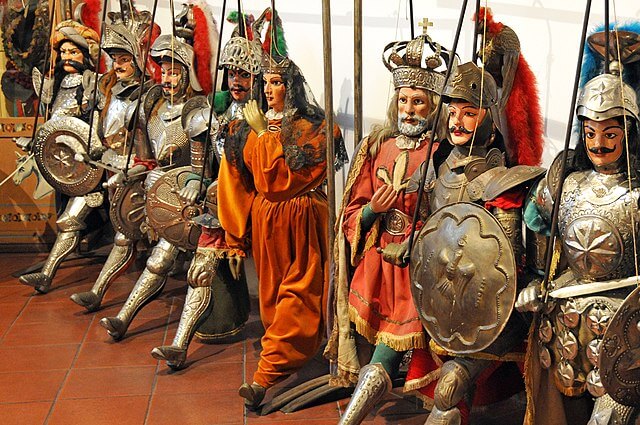 Medieval knights are a common element in Sicilian puppet theatre. The Norman conquest of Sicily is also enacted in many festivals on the island.
Medieval knights are a common element in Sicilian puppet theatre. The Norman conquest of Sicily is also enacted in many festivals on the island.Arab Influence in Sicily
Although the Muslim rule lasted only a relatively short period, their legacy remains. Muslims brought many things to Sicily, and the island was never the same.
The main (r)evolution happened in agriculture. The Muslims brought many plants for which Sicily is now known - like oranges, lemons, and pistachios.
They also introduced sugar cane. The island has a long tradition of desserts and other sweets thanks to it.
And the agricultural revolution was not limited to new varieties of crops. There was also a change in farming methods. The Emirate replaced the large estates - inherited from Roman times - with small farms.
The Muslims also reformed the irrigation system. As a result, agricultural production increased, enabling the island to prosper.
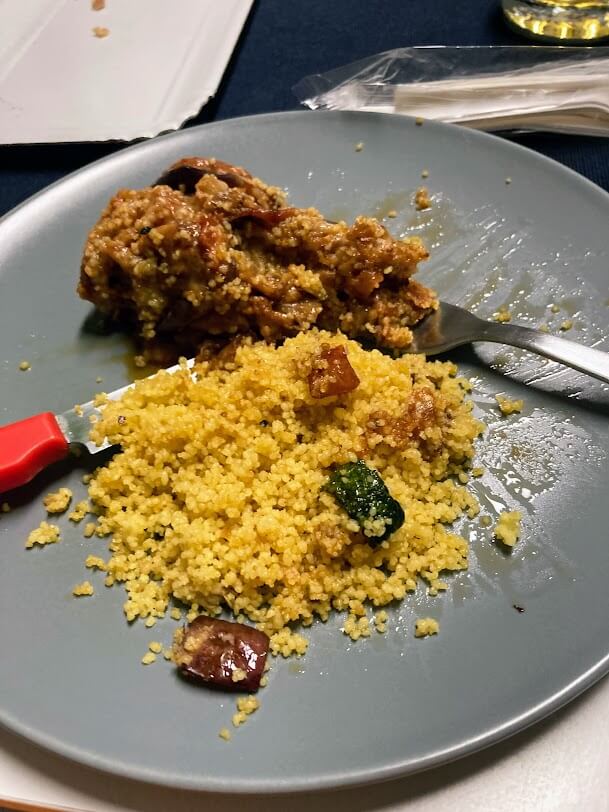 Couscous in Trapani.
Couscous in Trapani.The influences on food and architecture are still visible, especially in the western part of the island.
The food is spicier. North African influences are evident in pizzas and pasta alike. It is like eating at the crossroads of two cultures.
Arabic remained the language of government in Sicily even after the change of power. And you can still hear the Arab influence in the Sicilian dialect and place names.
The markets and street foods also have their origins in Arabic times. The market tradition has continued unbroken for more than a thousand years.
Conclusion
North African Muslims conquered Sicily from the Byzantines at the end of the first millennium AD. Their rule lasted for a couple of hundred years.
The Muslims brought many reforms to Sicily. A radical change in agriculture brought prosperity to the island. Thanks to that, Sicily became a force to reckon with in the global arena.
The Normans, who had arrived in southern Italy as mercenaries, eventually conquered Sicily from the Muslims.
Even after the change of power, the Muslims remained the largest group on the island until the 13th century.
The Muslim influence can still be seen and heard - in architecture, food, and language.
(This page last edited: June 5, 2025.)
Recent Articles
-
Honeymoon in Sicily: Where Landscapes Stir the Heart
Dec 17, 25 12:21 PM
Honeymoon in Sicily: Timeless temples, coastal hideaways, slow meals, and landscapes that invite closeness. -
Best Time to Visit Sicily: Your Seasonal Guide
Dec 05, 25 04:23 AM
Find the best time to visit Sicily. Explore seasonal weather, crowds, prices, and highlights. -
Where to Stay in Sicily: Top Areas for Every Traveler
Nov 27, 25 08:14 AM
Where to stay in Sicily: A guide to the island’s best regions, helping you choose the perfect base for your trip.
Follow MANY FACES OF SICILY on Facebook, Instagram, Bluesky & Tumblr
Contact: vesa@manyfacesofsicily.com
